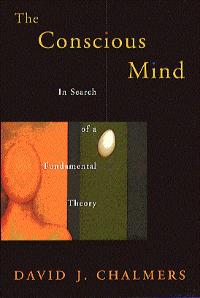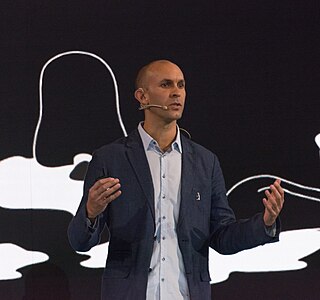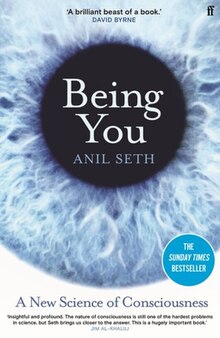
Consciousness, at its simplest, is awareness of internal and external existence. However, its nature has led to millennia of analyses, explanations and debate by philosophers, theologians, and all of science. Opinions differ about what exactly needs to be studied or even considered consciousness. In some explanations, it is synonymous with the mind, and at other times, an aspect of mind. In the past, it was one's "inner life", the world of introspection, of private thought, imagination and volition. Today, it often includes any kind of cognition, experience, feeling or perception. It may be awareness, awareness of awareness, or self-awareness either continuously changing or not. The disparate range of research, notions and speculations raises a curiosity about whether the right questions are being asked.
Epiphenomenalism is a position on the mind–body problem which holds that subjective mental events are completely dependent for their existence on corresponding physical and biochemical events within the human body, yet themselves have no influence over physical events. According to epiphenomenalism, the appearance that subjective mental states influence physical events is an illusion, consciousness being a by-product of physical states of the world. For instance, fear seems to make the heart beat faster, but according to epiphenomenalism the biochemical secretions of the brain and nervous system —not the experience of fear—is what raises the heartbeat. Because mental events are a kind of overflow that cannot cause anything physical, yet have non-physical properties, epiphenomenalism is viewed as a form of property dualism.

Consciousness Explained is a 1991 book by the American philosopher Daniel Dennett, in which the author offers an account of how consciousness arises from interaction of physical and cognitive processes in the brain. Dennett describes consciousness as an account of the various calculations occurring in the brain at close to the same time. He compares consciousness to an academic paper that is being developed or edited in the hands of multiple people at one time, the "multiple drafts" theory of consciousness. In this analogy, "the paper" exists even though there is no single, unified paper. When people report on their inner experiences, Dennett considers their reports to be more like theorizing than like describing. These reports may be informative, he says, but a psychologist is not to take them at face value. Dennett describes several phenomena that show that perception is more limited and less reliable than we perceive it to be.

Sentience is the simplest or most primitive form of cognition, consisting of a conscious awareness of stimuli without association or interpretation. The word was first coined by philosophers in the 1630s for the concept of an ability to feel, derived from Latin sentiens (feeling), to distinguish it from the ability to think (reason).
Artificial consciousness (AC), also known as machine consciousness (MC), synthetic consciousness or digital consciousness, is the consciousness hypothesized to be possible in artificial intelligence. It is also the corresponding field of study, which draws insights from philosophy of mind, philosophy of artificial intelligence, cognitive science and neuroscience. The same terminology can be used with the term "sentience" instead of "consciousness" when specifically designating phenomenal consciousness.

In the philosophy of mind, panpsychism is the view that the mind or a mind-like aspect is a fundamental and ubiquitous feature of reality. It is also described as a theory that "the mind is a fundamental feature of the world which exists throughout the universe". It is one of the oldest philosophical theories, and has been ascribed to philosophers including Thales, Plato, Spinoza, Leibniz, William James, Alfred North Whitehead, Bertrand Russell, and Galen Strawson. In the 19th century, panpsychism was the default philosophy of mind in Western thought, but it saw a decline in the mid-20th century with the rise of logical positivism. Recent interest in the hard problem of consciousness and developments in the fields of neuroscience, psychology, and quantum mechanics have revived interest in panpsychism in the 21st century.

In the philosophy of mind, the hard problem of consciousness is to explain why and how humans and other organisms have qualia, phenomenal consciousness, or subjective experience. It is contrasted with the "easy problems" of explaining why and how physical systems give a (healthy) human being the ability to discriminate, to integrate information, and to perform behavioral functions such as watching, listening, speaking, and so forth. The easy problems are amenable to functional explanation—that is, explanations that are mechanistic or behavioral—since each physical system can be explained purely by reference to the "structure and dynamics" that underpin the phenomenon.
Electromagnetic theories of consciousness propose that consciousness can be understood as an electromagnetic phenomenon.
Bicameral mentality is a hypothesis introduced by Julian Jaynes who argued human ancestors as late as the ancient Greeks did not consider emotions and desires as stemming from their own minds but as the consequences of actions of gods external to themselves. The theory posits that the human mind once operated in a state in which cognitive functions were divided between one part of the brain which appears to be "speaking", and a second part which listens and obeys—a bicameral mind, and that the breakdown of this division gave rise to consciousness in humans. The term was coined by Jaynes, who presented the idea in his 1976 book The Origin of Consciousness in the Breakdown of the Bicameral Mind wherein he made the case that a bicameral mentality was the normal and ubiquitous state of the human mind as recently as 3,000 years ago, near the end of the Mediterranean bronze age.
Jeffrey Alan Gray was a British research psychologist. Probably his most important contribution to science and humanity is his biopsychological theory of personality. He is also notable for his contributions to the theory of consciousness.
The Philosophy of mind is a branch of philosophy that deals with the nature of the mind and its relation to the body and the external world.

The mind–body problem is a philosophical problem concerning the relationship between thought and consciousness in the human mind, and the body.
Primary consciousness is a term the American biologist Gerald Edelman coined to describe the ability, found in humans and some animals, to integrate observed events with memory to create an awareness of the present and immediate past of the world around them. This form of consciousness is also sometimes called "sensory consciousness". Put another way, primary consciousness is the presence of various subjective sensory contents of consciousness such as sensations, perceptions, and mental images. For example, primary consciousness includes a person's experience of the blueness of the ocean, a bird's song, and the feeling of pain. Thus, primary consciousness refers to being mentally aware of things in the world in the present without any sense of past and future; it is composed of mental images bound to a time around the measurable present.

In philosophy of mind, qualia are defined as instances of subjective, conscious experience. The term qualia derives from the Latin neuter plural form (qualia) of the Latin adjective quālis meaning "of what sort" or "of what kind" in relation to a specific instance, such as "what it is like to taste a specific apple — this particular apple now".

The Conscious Mind: In Search of a Fundamental Theory was published in 1996, and is the first book written by David Chalmers, an Australian philosopher specialising in philosophy of mind. Although the book has been greatly influential, Chalmers maintains that it is "far from perfect", as most of it was written as part of his PhD dissertation after "studying philosophy for only four years".
Interactionism or interactionist dualism is the theory in the philosophy of mind which holds that matter and mind are two distinct and independent substances that exert causal effects on one another. An example of your mind influencing your body would be if you are depressed, you can observe the effects on your body, such as a slouched posture, a lackluster smile, etc. Another example, this time of your body affecting your mind would be: If you struck your toe very forcefully on a door, you would experience terrible pain. Interactionism is one type of dualism, traditionally a type of substance dualism though more recently also sometimes a form of property dualism. Many philosophers and scientists have responded to this theory with arguments both supporting and opposing its relevance to life and whether the theory corresponds to reality.

Integrated information theory (IIT) proposes a mathematical model for the consciousness of a system. It comprises a framework ultimately intended to explain why some physical systems are conscious, and to be capable of providing a concrete inference about whether any physical system is conscious, to what degree, and what particular experience it is having; why they feel the particular way they do in particular states, and what it would take for other physical systems to be conscious.

Anil Kumar Seth is a British neuroscientist and professor of Cognitive and Computational Neuroscience at the University of Sussex. A proponent of materialist explanations of consciousness, he is currently amongst the most cited scholars on the topics of neuroscience and cognitive science globally.

Donald David Hoffman is an American cognitive psychologist and popular science author. He is a professor in the Department of Cognitive Sciences at the University of California, Irvine, with joint appointments in the Department of Philosophy, the Department of Logic and Philosophy of Science, and the School of Computer Science.
Models of consciousness are used to illustrate and aid in understanding and explaining distinctive aspects of consciousness. Sometimes the models are labeled theories of consciousness. Anil Seth defines such models as those that relate brain phenomena such as fast irregular electrical activity and widespread brain activation to properties of consciousness such as qualia. Seth allows for different types of models including mathematical, logical, verbal and conceptual models.










